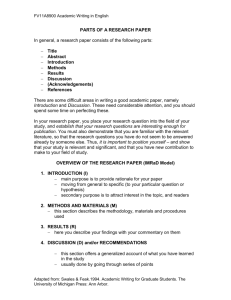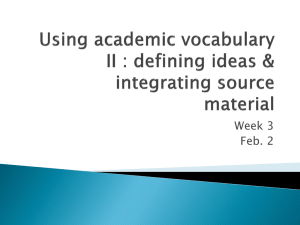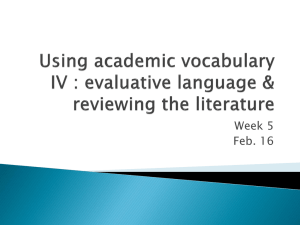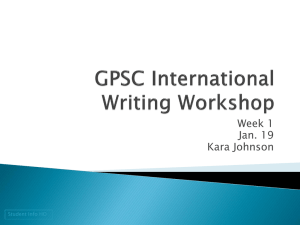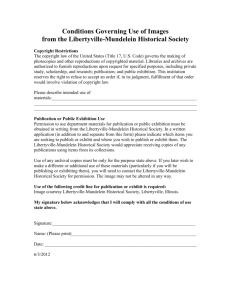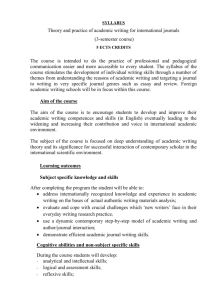The Foundation for Exhibiting Art & Knowledge
advertisement
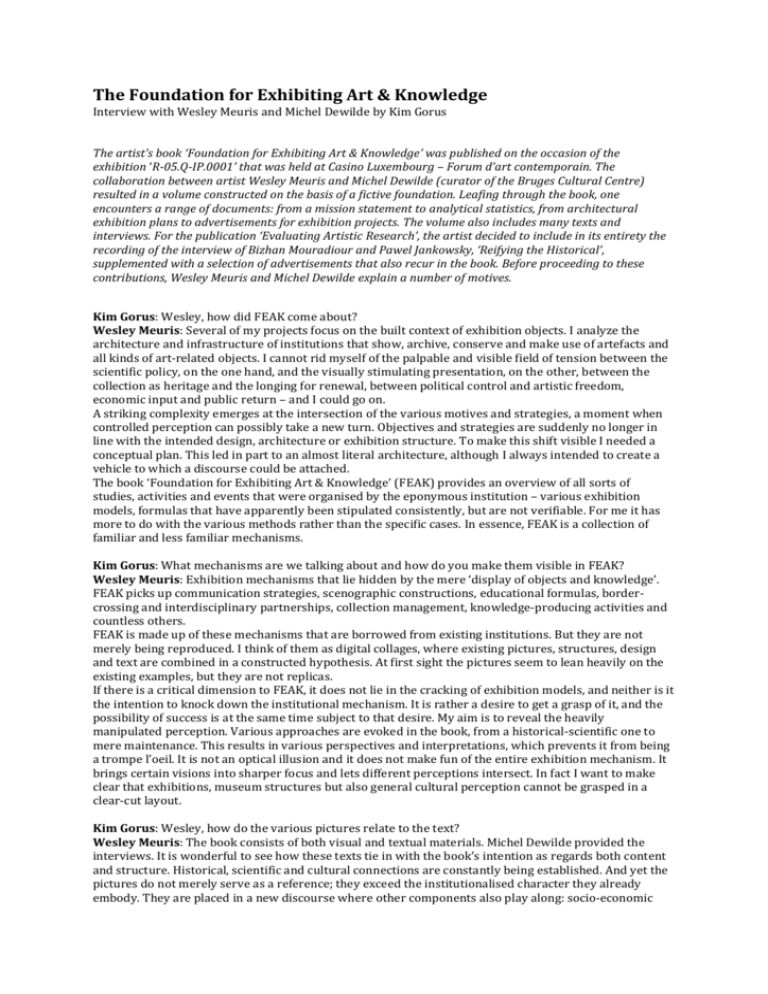
The Foundation for Exhibiting Art & Knowledge Interview with Wesley Meuris and Michel Dewilde by Kim Gorus The artist’s book ‘Foundation for Exhibiting Art & Knowledge’ was published on the occasion of the exhibition ‘R-05.Q-IP.0001’ that was held at Casino Luxembourg – Forum d’art contemporain. The collaboration between artist Wesley Meuris and Michel Dewilde (curator of the Bruges Cultural Centre) resulted in a volume constructed on the basis of a fictive foundation. Leafing through the book, one encounters a range of documents: from a mission statement to analytical statistics, from architectural exhibition plans to advertisements for exhibition projects. The volume also includes many texts and interviews. For the publication ‘Evaluating Artistic Research’, the artist decided to include in its entirety the recording of the interview of Bizhan Mouradiour and Pawel Jankowsky, ‘Reifying the Historical’, supplemented with a selection of advertisements that also recur in the book. Before proceeding to these contributions, Wesley Meuris and Michel Dewilde explain a number of motives. Kim Gorus: Wesley, how did FEAK come about? Wesley Meuris: Several of my projects focus on the built context of exhibition objects. I analyze the architecture and infrastructure of institutions that show, archive, conserve and make use of artefacts and all kinds of art-related objects. I cannot rid myself of the palpable and visible field of tension between the scientific policy, on the one hand, and the visually stimulating presentation, on the other, between the collection as heritage and the longing for renewal, between political control and artistic freedom, economic input and public return – and I could go on. A striking complexity emerges at the intersection of the various motives and strategies, a moment when controlled perception can possibly take a new turn. Objectives and strategies are suddenly no longer in line with the intended design, architecture or exhibition structure. To make this shift visible I needed a conceptual plan. This led in part to an almost literal architecture, although I always intended to create a vehicle to which a discourse could be attached. The book ‘Foundation for Exhibiting Art & Knowledge’ (FEAK) provides an overview of all sorts of studies, activities and events that were organised by the eponymous institution – various exhibition models, formulas that have apparently been stipulated consistently, but are not verifiable. For me it has more to do with the various methods rather than the specific cases. In essence, FEAK is a collection of familiar and less familiar mechanisms. Kim Gorus: What mechanisms are we talking about and how do you make them visible in FEAK? Wesley Meuris: Exhibition mechanisms that lie hidden by the mere ‘display of objects and knowledge’. FEAK picks up communication strategies, scenographic constructions, educational formulas, bordercrossing and interdisciplinary partnerships, collection management, knowledge-producing activities and countless others. FEAK is made up of these mechanisms that are borrowed from existing institutions. But they are not merely being reproduced. I think of them as digital collages, where existing pictures, structures, design and text are combined in a constructed hypothesis. At first sight the pictures seem to lean heavily on the existing examples, but they are not replicas. If there is a critical dimension to FEAK, it does not lie in the cracking of exhibition models, and neither is it the intention to knock down the institutional mechanism. It is rather a desire to get a grasp of it, and the possibility of success is at the same time subject to that desire. My aim is to reveal the heavily manipulated perception. Various approaches are evoked in the book, from a historical-scientific one to mere maintenance. This results in various perspectives and interpretations, which prevents it from being a trompe l’oeil. It is not an optical illusion and it does not make fun of the entire exhibition mechanism. It brings certain visions into sharper focus and lets different perceptions intersect. In fact I want to make clear that exhibitions, museum structures but also general cultural perception cannot be grasped in a clear-cut layout. Kim Gorus: Wesley, how do the various pictures relate to the text? Wesley Meuris: The book consists of both visual and textual materials. Michel Dewilde provided the interviews. It is wonderful to see how these texts tie in with the book’s intention as regards both content and structure. Historical, scientific and cultural connections are constantly being established. And yet the pictures do not merely serve as a reference; they exceed the institutionalised character they already embody. They are placed in a new discourse where other components also play along: socio-economic topics, the political context, educational output, public activities, academic interests, even individual interests. Part of the visual material was specifically developed to visualize FEAK. Other pictures are borrowed from my own work, works that share a similar affinity. For instance, the scenographic project ‘Research Building, 2011’ and the installation ‘The World’s Most Important Artists, 2009’ were temporarily included in order to give shape to the construction of the exhibition apparatus FEAK, a goal that is only possible in the conceptual context of the book. Besides, there are countless existing drawings that are in the archive of this institution, architectural plans with titles such as ‘The Most Inspiring Fair of the World’, ‘An Outstanding Sculpture Garden’, ‘A Mosque with a Contemporary View’ and more. These works create the illusion of an overview but, given the complex structure and the enticing promotional language that has been added, immediately make the viewer doubt the display. I applied that same technique to the advertisements shown throughout the book, there where, by means of a nuanced strategy, pictures and text fragments come very close to adverts found in ‘Artforum’, ‘Frieze’ and other similar magazines. The information that is given is not absolute. The date is there but the year is missing; the activity being presented is recognizable but not traceable outside the announcement itself. Potential sponsors, organizers and other interested parties are mentioned. All this is rendered in a solid design; the typeface remains unaltered and the pictures are recycled. I have no graphic ambition with these works; they idolize aesthetics, but they have a conceptual motif. And yet this work transcends a purely conceptual issue. Both the advertisements and the other contributions in the book are based on a formal, architectural quest. It has to do with revelations of physical structures, exploited by strategies of classification and taxonomy. Kim Gorus: Michel, how did the collaboration with Wesley Meuris come about, and how would you describe the role of fictive identities in the publication? Michel Dewilde: The collaboration is the result of a combination of circumstances. We have been following Wesley Meuris’s artistic development closely since 2002. Our attention has focused in particular on his research into the human fascination for knowledge and meaning formation and the related, at times compulsive desire for classification systems such as taxonomy. I’m thinking in particular of his interest for the institutionalization of these domains. Those works are striking in which the museum world, its infrastructure, the developed methodology, the codes and regulations in use, and the ubiquitous exhibition culture occupy a central position. It is in that connection that I wanted to involve Meuris in a publication on exhibition design. But in response he proposed to work on his book within the FEAK project. FEAK interested me immediately. Besides, the intention showed similarities with my own research into exhibitions as a system of representations behind which lurk different ideological, political or even economic motives. I then decided to involve the members of the art collective Bałaganiarze in the preparation of the book. Together with Polish and Ukrainian artists I set up Bałaganiarze in Wrocław (2006) with the intention of scrutinizing the economic dimensions of the art world, the urge to impose oneself, the impact of networking and positioning, etc. The collective organized exhibitions in the form of stage plays, where Bałaganiarze embodied the roles of the artists, collector, critic, curator and more. For these ‘plays’ fictive figures such as the Polish-American artist-curator Pawel Jankowsky and the IndianIranian curator-sociologist Bizhan Mouradipour were presented as actors within the global art world. Ultimately Bałaganiarze decided to have these figures perform as characters in the FEAK publication. This publication introduces the older Mouradipour as a privileged witness of the establishment and development of the FEAK enterprise. Jankowsky, on the other hand, embodies the figure of the younger, more contemporary independent curator who keeps the activity and exhibition policy of FEAK contemporary. Kim Gorus: Michel, some authors link FEAK with institutional criticism? Michel Dewilde: It’s in the publication especially that I see a connection with institutional criticism, but in the artworks Meuris opts for a nuanced approach. So it is important not to reduce his practice to this dimension. What’s more, in my opinion this relation is the result of his in-depth analysis of the syntax, grammar, etc. of language and architecture in particular. The relation with institutional criticism is rather the consequence of this research than, for instance, a fascination for artists like Michael Asher, Daniel Buren, Hans Haacke and others. This makes me see his work method as virtually the reverse of that of, say, Ernst Neufert’s handbook for architects. Whereas Neufert aimed for a rationalization of all sorts of traditions and phenomena within architecture, Meuris chooses for the opposite path: he unravels the often surreal and even worrying aspects of customary models and standard forms. In essence he designs sculptures based on existing examples with a secret, almost imperceptible critical undertone. As a result, depending on the exhibition context, a certain reading of the work can either be accentuated or silenced. In the beautiful FEAK exhibition in Casino Luxembourg – Forum d’art contemporain, for instance, he combines both: we see sculptures with an explicit self-referential and critical component, while others suppress this aspect, which often confuses the viewer. The publication and its applications such as the FEAK website tie in with recent forms of institutional criticism as found in the work of Gianni Motti or activist groups like The Yes Men. In this I was drawn in particular to the parasitic potential of the FEAK enterprise. In the book FEAK functions as a so-called mock institution, a fictive organization with which one can actively infiltrate the art world. This is another connection with the objectives of Bałaganiarze, since the group imitates the activities of some artists or curator collectives with the intention of notably revealing their economic or ideological connections. Kim Gorus: Michel, can you outline the different layers of meaning in the texts of the FEAK book? Michel Dewilde: Meuris developed FEAK as an aesthetic vehicle for his research and this led to a series of multilayered discourses. My intention was also to translate this complex structure in the texts of the publication. We thereby combine the history of the FEAK enterprise with a series of contextual analyses of more general, but nevertheless related subjects. In this sense FEAK plays as much on the contemporary visual grammar of the art market and its communication, the commercialization and spectacularization, as on their relation to exhibition design. The labyrinthine publication consists of three types of text: the book opens with the introduction by the fictional editor; this is followed by the main text in the form of a fictive discussion between Pawel Jankowsky and Bizhan Mouradipour; and the book concludes with three ‘genuine interviews’ with renowned experts Mary Anne Staniszewski, Charlotte Klonk and Julia Noordegraaf. Just like Meuris’s artworks within the FEAK exhibitions, the texts constantly switch from one dimension and fiction to the other. Thus the main text relates with the necessary irony not only the emergence of the FEAK enterprise, but also includes analyses of recent developments within the art world. Then the ‘real interviews’ throw light on a number of topics within the history of exhibition design and specifically the relation with the art installation; they also lend ‘scientific credibility’ to FEAK. In addition, these ‘real interviews’ play on the typical intertwining of the art product with its own discourse and institutions. Besides, these ‘real interviews’ previously appeared in the ‘fictive’ FEAK magazine. In this way FEAK produces not only its own discourse but also the critical analysis and historical contextualization of its own cultural products. Lastly, with FEAK Meuris plays on the growing importance of research within the arts. Meuris here involves a curator and a series of reputed scientists in his own artistic research, and combines this at a meta-level with a presentation, analysis and the archiving of types of artistic research. This play with mirror structures, over-identification, fictions and fictiveness refers to certain surreal and obsessional dimensions of the art industry, an outlook we encounter in his own artistic practice.
